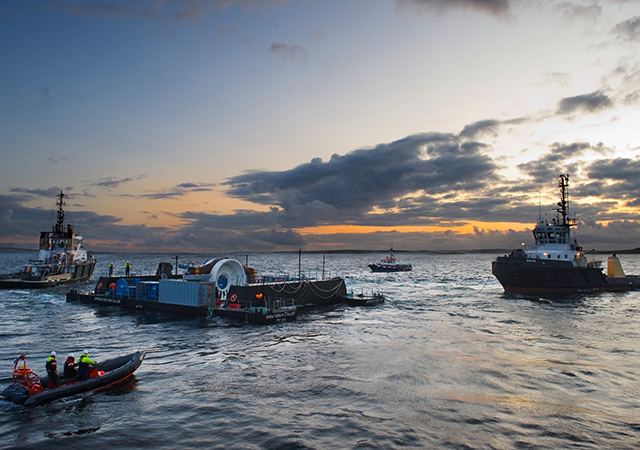
A week ago, media headlines focused on the jobs that renewable energy developments could bring to the Northern and Western Isles of Scotland by 2030, so long as the right economic greenhouse environment was created.
The Scottish Government’s “Scottish Islands Renewable Report” indicated that around 1,200 new jobs could be created by 2020, rising sharply to a collective 11,000 or so jobs by 2030.
The knock-on benefits to the wider UK could be about 3,000 and 29,000 full-time equivalent jobs.
In other words, the study suggests that more or less 60,000 jobs are possible by the end of the next decade, so long as government, industry, the banks and other key stakeholders grasp the nettle and deliver.
Failure to do so means that the best opportunity for many decades to diversify and reinforce what are largely fragile economies would be lost, in particular the Western Isles.
Even though Orkney and Shetland continue to benefit considerably from offshore oil, the impact of missing a long-term sustainable business opportunity cannot be discounted.
There are four key factors that will determine the level of success or failure of renewables in Orkney, Shetland and the Western Isles.
They are:
- The funding gap
- Grid access . . . availability of appropriate infrastructure coupled with transmission charges
- Availability of early-stage funding for marine projects
- Underpinning development of an effective supply chain
Of these, the first two are by far the most important, according to the consultants who prepared the report.
Indisputably, the Scottish Islands offer some of the best sites for renewables projects anywhere in the UK, and indeed Europe, thanks to rich wind, wave and tidal resources.
As such, the belief is that projects in these areas should produce significantly greater revenues than their mainland equivalents.
Yet, due to the challenges that confront the ambition, Scottish Island renewables projects, and onshore wind plant in particular, also incur comparatively higher costs which negate the benefits of the higher yields.
The funding gap
The cost challenges are associated with the remote locations and harsh operating conditions.
“For wind plant, we estimate that these factors increase the costs of construction by around 20%, and may, in some cases, more than double cost of operation,” say the consultants.
“However, by far the biggest cost element is associated with the links required to connect the plant to the transmission system (since the output from the plant would be well in excess of local demands).”
The costs of installing subsea interconnectors between the islands and the mainland, and associated onshore reinforcements are very high.
For example, the cost of the HVDC (high-voltage direct current) cable to Lewis alone is more than £700million.
The methodologies for calculating transmission charges are currently under review through the Project TransmiT/CMP213 process. However, it is likely that a significant proportion of the incremental costs of the transmission upgrades would be charged to island generators.
Taking into account the higher revenues and higher costs associated with island wind projects, the analysis suggests that in aggregate they are typically between around £19 and £45 per MWh (Megawatt hour) more expensive on a “levelised” basis than their mainland equivalents; with Orkney and Shetland at the lower end (with levelised costs of £103 per MWh and £106 MWh respectively), and the Western Isles at the higher end (£129 per MWh3,
A different outcome from the current review of transmission charging (for example, including a lower proportion of HVDC converter costs in the local charge component) could lower the difference with mainland projects to between £14 per MWh and £36 per MWh.
The consultants warn: “Our analysis concludes that, under current policy (0.9 ROCs – renewables obligation certificate – per MWh) it is unlikely to be economic to develop further onshore wind projects on the islands as returns will not meet the required hurdle rates.
However, the costs of Scottish Islands onshore wind, with the exception of onshore wind on the Western Isles, are in the same range as several other forms of low carbon generation being considered by
There is little existing local grid network, and hence new projects are reliant on various proposed new transmission links.
These have been delayed, in part due to cost escalations (in the case of the Western Isles link) and in part due to lack of confidence in the needs cases given the uncertainty of whether projects will be able to afford the works required without visibility of any further potential financial support above that currently being offered.
“For some developers, particularly for smaller or community projects or those with new technologies, the grid access challenge is even greater since they are unable to underwrite the liabilities and associated security requirements needed to secure capacity on future transmission links,” say the consultants.
“As a result these developers are dependent on ‘anchor projects’, such as large windfarms in the Western Isles or Shetland or large marine projects in Orkney, to underwrite new transmission investment, and hope that there is sufficient spare transmission capacity to accommodate their projects.
“While these user commitment rules are doing what they are designed to do, which is to protect consumers from stranding of transmission assets associated with higher risk generation projects, they place potentially undue barriers to developers of new marine technologies.
“If the policy intent is to promote marine generation, having a regulatory regime that can create barriers may appear counter-productive, especially when compared to other countries where connections for emerging technologies are prioritised.
“For these reasons there may be grounds for pursuing measures that lower the risks of securing transmission capacity for certain classes of developers.”
In that regard the writer suggests that there may be similarities with the North Sea offshore industry where infrastructure access remains an major and intractable problem, especially for the owners/operators of small oil and gas assets.
“On the basis of our study, we have concluded that the costs of deploying renewables on a large scale on the Scottish Islands is high,” warn the consultants.
“However, onshore wind on the Scottish Islands is cost competitive with several other forms of low carbon generation and, particularly in the case of Orkney and Shetland, is significantly cheaper than (UK) Round 3 offshore wind.”
They insist that, aside from local jobs creation, “there is an opportunity to establish Scotland as a world leader in marine technologies”. However, in the just-published renewables edition of The Press and Journal’s supplement Energy, columnist Dick Winchester exposes how foreign interests control nearly all the wave and tidal technologies on trial at the European Marine Energy Centre, Orkney.
The consultants warn that further renewables generation on the Scottish Islands will not happen near-term or under current policy.
Recommended for you
